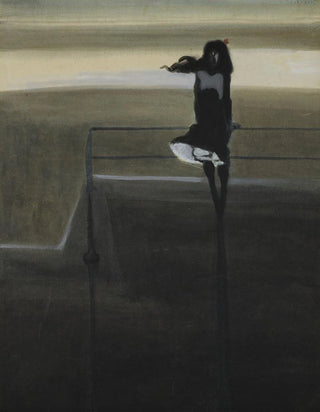Art print | The gust of wind - Léon Spilliaert Source: Reproduction | La rafale de vent - Léon Spilliaert


View from behind

Frame (optional)
In the fascinating world of art, some works manage to capture the very essence of nature and human emotion. "The Gust of Wind" by Léon Spilliaert stands out as a compelling example of this ability to transcend mere visuals and evoke a sensory experience. Contemplating this piece, the viewer is immediately transported to a landscape where the power of the wind seems almost tangible. The nuances of color, dynamic shapes, and play of light invite complete immersion, creating a dialogue between the artwork and the observer. This piece, both delicate and energetic, embodies the swirling spirit of the North Sea while revealing the depths of the human soul.
Style and uniqueness of the work
One of the most striking features of "The Gust of Wind" lies in its unique style, which combines symbolism with expressionist influences. Spilliaert uses a palette of dark colors, contrasted by flashes of light that seem to burst from the canvas. This approach gives the artwork a mysterious, almost dreamlike atmosphere, where the sea and sky blend in a tumultuous dance. The fluid shapes and sinuous lines evoke the relentless movement of waves and gusts of wind, while the silhouettes of the characters, often solitary, reinforce a sense of melancholy. The singularity of this piece also resides in its ability to evoke deep emotions, prompting the viewer to reflect on the human condition in the face of nature.
The artist and his influence
Léon Spilliaert, an emblematic figure of Belgian art in the early 20th century, established himself as a master of atmosphere and emotion. His career, marked by diverse influences ranging from symbolism to expressionism, was deeply nourished by his personal experiences and environment. The sea, in particular, played a central role in his work, becoming a recurring motif that symbolizes both the beauty and danger of nature. Spilliaert was also influenced by the artistic movements of his time, but he developed a personal style that is uniquely his own.

Matte finish

View from behind

Frame (optional)
In the fascinating world of art, some works manage to capture the very essence of nature and human emotion. "The Gust of Wind" by Léon Spilliaert stands out as a compelling example of this ability to transcend mere visuals and evoke a sensory experience. Contemplating this piece, the viewer is immediately transported to a landscape where the power of the wind seems almost tangible. The nuances of color, dynamic shapes, and play of light invite complete immersion, creating a dialogue between the artwork and the observer. This piece, both delicate and energetic, embodies the swirling spirit of the North Sea while revealing the depths of the human soul.
Style and uniqueness of the work
One of the most striking features of "The Gust of Wind" lies in its unique style, which combines symbolism with expressionist influences. Spilliaert uses a palette of dark colors, contrasted by flashes of light that seem to burst from the canvas. This approach gives the artwork a mysterious, almost dreamlike atmosphere, where the sea and sky blend in a tumultuous dance. The fluid shapes and sinuous lines evoke the relentless movement of waves and gusts of wind, while the silhouettes of the characters, often solitary, reinforce a sense of melancholy. The singularity of this piece also resides in its ability to evoke deep emotions, prompting the viewer to reflect on the human condition in the face of nature.
The artist and his influence
Léon Spilliaert, an emblematic figure of Belgian art in the early 20th century, established himself as a master of atmosphere and emotion. His career, marked by diverse influences ranging from symbolism to expressionism, was deeply nourished by his personal experiences and environment. The sea, in particular, played a central role in his work, becoming a recurring motif that symbolizes both the beauty and danger of nature. Spilliaert was also influenced by the artistic movements of his time, but he developed a personal style that is uniquely his own.






